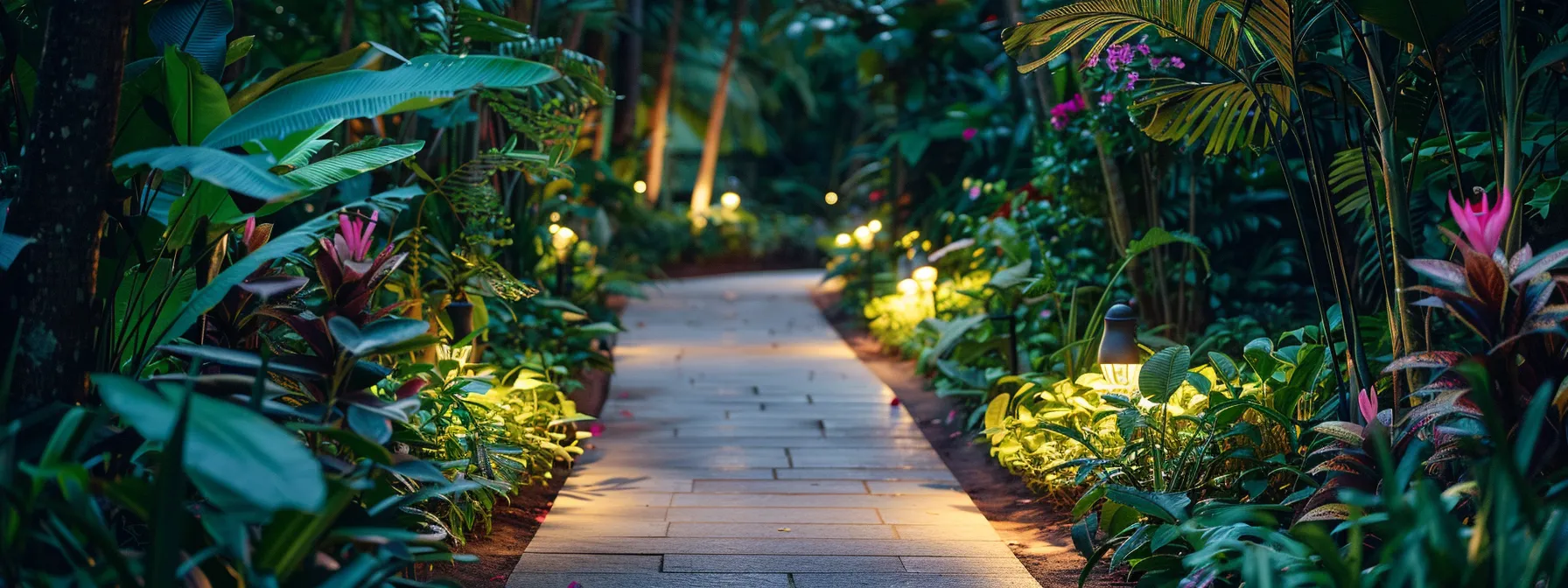Is your outdoor space lacking the ambiance it deserves? Many homeowners overlook the transformative power of effective landscape lighting. This guide will explore the importance of choosing and installing the perfect landscape lighting, assessing your outdoor space, and selecting the right fixtures. By understanding these elements, readers will enhance their property’s curb appeal and functionality while overcoming common challenges in outdoor lighting installation. With insights from experienced outdoor lighting contractors, this article will help turn your vision into reality and simplify your search for “outdoor lighting installation near me.”
Key Takeaways
- proper landscape lighting enhances curb appeal and improves safety for outdoor spaces
- selecting the right fixtures and bulbs is essential for effective illumination and energy efficiency
- strategic placement of lights creates a warm atmosphere and highlights key landscape features
- routine maintenance ensures longevity and optimal performance of the lighting system
- smart controls offer convenience and enhance energy efficiency in outdoor lighting management
Understanding the Importance of Landscape Lighting

Installing landscape lighting plays a crucial role in enhancing a home’s curb appeal, improving safety and security, and creating a warm outdoor atmosphere. Effective exterior lighting installation not only highlights architectural features and landscaping elements but also provides necessary illumination for pathways and walls, reducing potential hazards. Additionally, understanding electrical wiring and proper voltage for lighting fixtures ensures a safe, long-lasting landscaper installation.
Enhance Your Home’s Curb Appeal With Lighting
Proper landscape lighting can significantly enhance a home’s curb appeal by illuminating key features and creating a welcoming ambiance. Strategically placing lighting along pathways and flower beds mulched with fresh material can guide visitors safely and highlight the beauty of the lawn, particularly when focused on well-maintained shrubs and trees. It’s essential to consult with an electrician to assess potential voltage drop across the wiring to ensure consistent brightness, allowing every illuminated feature to shine effectively.
| Aspect | Effect of Landscape Lighting |
|---|---|
| Pathway Lighting | Increases safety by illuminating walkways. |
| Architectural Highlights | Draws attention to home features, adding visual interest. |
| Garden Illumination | Enhances the beauty of mulched areas and planted features. |
| Overall Ambiance | Creates a warm, inviting atmosphere for gatherings. |
Improve Safety and Security Around Your Property
Enhancing safety and security around a property starts with proper landscape lighting. By illuminating paths and key areas, homeowners can significantly reduce hazards and deter potential intruders. Using a tape measure to determine the ideal length for power cords and the strategic placement of lights ensures sufficient brightness along walkways, while securely fastening connections with electrical tape can prevent accidents and prolong the lifespan of the installation.
Create a Warm and Inviting Outdoor Atmosphere
Creating a warm and inviting outdoor atmosphere is essential for maximizing the enjoyment of exterior spaces. Proper outdoor light installation, such as using soft-watt bulbs placed strategically, can transform areas like patios and gardens into welcoming retreats for family and guests. Following the national electrical code ensures safety during the installation, particularly when securing fixtures with screws and verifying wattage requirements, making the outdoor environment both beautiful and functional.
Light transforms a space, revealing its hidden beauty. Next, it is time to look closely at your outdoor area and identify where that light should shine.
Assessing Your Outdoor Space for Lighting Needs

Assessing the outdoor space for lighting needs involves three key considerations. First, identifying important landscape features to illuminate can enhance the property’s aesthetics. Second, determining functional lighting areas ensures safety and usability for activities. Finally, considering environmental and weather factors will inform choices regarding durable materials and optimal installation techniques using tools like a drill, wire stripper, and the right size drill bit for the job.
Identify Key Landscape Features to Illuminate
Identifying key landscape features to illuminate is essential when planning outdoor lighting. Homeowners should focus on highlighting architectural elements and natural features, such as trees, flower beds, and pathways, to enhance the property’s aesthetic appeal and safety. Utilizing a variety of light fixtures can create depth and interest while addressing functional needs, so consulting with local landscaping lighting companies near me can provide insights on the best fixtures for specific areas and volt requirements.
| Key Feature | Recommended Lighting Approach |
|---|---|
| Trees | Up-lighting to showcase height and structure. |
| Pathways | Consistent down lighting for safety and visual guidance. |
| Garden Beds | Accent lighting to highlight colors and textures. |
| Architectural Details | Spotlights to draw attention to unique features. |
Determine Functional Lighting Areas for Activities
Determining functional lighting areas for activities is essential for maximizing the usability of outdoor spaces. Homeowners should focus on areas where they gather, such as patios and decks, ensuring these spots are well-lit for evening use. Engaging local outdoor lighting companies near me can provide valuable insights and help secure low voltage fixtures that are safe and energy-efficient. Proper installation may involve using a shovel and bit to dig appropriate trenches for wiring, ensuring a tidy setup that complements the landscape.
Consider Environmental and Weather Factors
Considering environmental and weather factors is critical for effective landscape lighting installation. The choice between high voltage and low voltage lighting installation can impact durability and safety, especially in areas prone to harsh weather. A skilled handyman should account for the local climate when selecting materials and fixtures, utilizing weather-resistant options and ensuring proper placement to minimize potential damage during storms or snowfall. For garden lighting installation, it is vital to secure fixtures appropriately using a screwdriver to prevent displacement and ensure reliability over time.
You have assessed your outdoor space and understand its needs. Now it’s time to explore the best options for landscape lighting fixtures that will enhance your vision and bring your design to life.
Choosing the Right Landscape Lighting Fixtures

Choosing the Right Landscape Lighting Fixtures
When selecting landscape lighting fixtures, homeowners should explore different types of lighting options, such as path lights, spotlights, and uplights. It’s essential to select appropriate bulbs and LED options based on energy efficiency and brightness needs. Additionally, deciding between solar and low-voltage systems involves considering the installation requirements, including the use of electrical cable and wire connections, ensuring a durable setup. Understanding these factors will guide the installation process and enhance the outdoor environment.
Explore Different Types of Lighting Fixtures
Homeowners seeking to enhance their outdoor space should consider various types of landscape lighting fixtures available on the market. Path lights are ideal for illuminating walkways and ensuring safety, while spotlights draw attention to architectural features and beautiful plants. Uplights serve to showcase trees and tall shrubs, adding depth and dimension to the landscape, making each area stand out effectively:
| Type of Fixture | Best Use |
|---|---|
| Path Lights | Illuminating walkways for safety. |
| Spotlights | Highlighting architectural features or focal points. |
| Uplights | Showcasing trees and tall shrubs. |
| Flood Lights | Providing broad illumination for large areas. |
Select Appropriate Bulbs and LED Options
Selecting the appropriate bulbs and LED options plays a significant role in achieving effective landscape lighting. Homeowners should consider energy-efficient LED bulbs, as they not only consume less power but also have a longer lifespan compared to traditional incandescent bulbs. Furthermore, understanding the brightness, measured in lumens, helps ensure that each lighting fixture provides adequate illumination for its specific application, enhancing both functionality and aesthetics:
| Type of Bulb | Characteristics |
|---|---|
| LED Bulbs | Energy-efficient, long-lasting, and available in various colors and brightness levels. |
| Incandescent Bulbs | Traditional choice with warm light, but shorter lifespan and higher energy consumption. |
| Halogen Bulbs | Bright illumination with better efficiency than incandescent, but still less than LED. |
| Solar Bulbs | Eco-friendly and cost-effective, but performance may vary based on sunlight exposure. |
Decide Between Solar and Low-Voltage Systems
When deciding between solar and low-voltage systems for landscape lighting, homeowners should consider the specific needs of their outdoor spaces. Solar lights are easy to install and require no wiring, making them an excellent option for those seeking a hassle-free solution; however, their performance can vary based on sunlight availability. On the other hand, low-voltage systems provide consistent brightness and greater control over lighting design, requiring some electrical expertise during installation, but offering enhanced durability and the ability to illuminate larger areas effectively.
Choosing the right fixtures sets the stage, but planning the project gives it life. With a clear plan, the vision starts to take shape, illuminating every corner of your landscape.
Planning Your Landscape Lighting Project

Developing a strategic lighting layout plan is essential for achieving the desired effect in landscape lighting. This includes calculating power requirements and energy usage to ensure efficiency. Moreover, choosing the proper transformers and accessories plays a significant role in the overall performance of the lighting system. Each of these steps ensures a well-coordinated and functional outdoor lighting project.
Develop a Strategic Lighting Layout Plan
Developing a strategic lighting layout plan involves mapping out the specific areas of the outdoor space that require illumination. Homeowners should take the time to identify key features, such as paths, trees, and seating areas, to ensure a well-distributed lighting design. By considering factors like the brightness of fixtures and the placement of power sources, individuals can achieve an effective and visually appealing lighting arrangement that enhances both safety and aesthetic appeal.
Calculate Power Requirements and Energy Usage
Calculating power requirements and energy usage is fundamental in planning a landscape lighting project. Homeowners should first determine the wattage of each fixture and total the desired number of lights to establish the overall power consumption. This ensures that the landscape lighting system operates effectively without overloading the electrical circuit, allowing for safe and efficient installation that meets both aesthetic and functional needs.
| Fixture Type | Wattage per Fixture | No. of Fixtures | Total Wattage |
|---|---|---|---|
| Path Light | 5W | 10 | 50W |
| Spotlight | 10W | 5 | 50W |
| Uplight | 15W | 3 | 45W |
| Total | 145W |
Choose the Proper Transformers and Accessories
Choosing the proper transformers and accessories is vital for the success of any landscape lighting project. These components must match the wattage requirements of the lighting fixtures to ensure optimal performance and prevent overloading or underpowering the system. Selecting accessories such as connectors, stakes, and mounting brackets can further enhance the installation’s stability and aesthetic appeal:
| Component | Role in Landscape Lighting |
|---|---|
| Transformer | Converts high voltage to low voltage for safety and efficiency. |
| Connectors | Ensure secure wiring connections for reliable functionality. |
| Mounting Brackets | Help secure fixtures into desired positions for precise illumination. |
| Stakes | Support fixtures in place for durability and correct alignment. |
Your plan is set. Now, it’s time to install your landscape lighting step by step, ensuring every corner shines just right.
Installing Your Landscape Lighting Step by Step

Installing landscape lighting involves several key steps for achieving optimal results. First, homeowners will gather the necessary tools and materials, followed by installing transformers and setting up power sources. Next, they will run wiring and connect lighting fixtures, ensuring correct placement for maximum effect. Finally, testing the system and making adjustments as needed will guarantee effective illumination throughout the outdoor space.
Gather Necessary Tools and Materials
Gathering the necessary tools and materials is a foundational step in installing landscape lighting effectively. Homeowners should prepare items such as solar or low-voltage lights, wiring, connectors, and a transformer to ensure a seamless installation process. Additionally, having tools like a shovel, drill, and electric tape on hand will facilitate a proper setup, allowing for efficient placement of fixtures and connections, ultimately enhancing the outdoor ambiance.
Install Transformers and Set Up Power Sources
Installing transformers and setting up power sources is a critical step in creating an effective landscape lighting system. Homeowners should select a transformer that matches the total wattage of their lighting fixtures to ensure optimal performance and efficiency. Proper placement of the transformer, preferably near a power outlet and protected from moisture, is essential to facilitate easy access and maintain the integrity of the system over time.
Run Wiring and Connect Lighting Fixtures
Running wiring and connecting lighting fixtures is a crucial step in the landscape lighting installation process. Homeowners should carefully lay out the wiring according to the planned lighting design, ensuring it is hidden beneath the soil or mulch to maintain a clean appearance. When connecting fixtures, it’s essential to secure all connections with weather-resistant connectors, which helps prevent issues with moisture and ensures reliable performance of the landscape lighting system. Proper placement and secure connections not only enhance the lighting’s effectiveness but also contribute to the overall safety and longevity of the installation.
Position Lights for Optimal Effect
Positioning lights correctly is crucial for creating an effective landscape lighting design. Homeowners should place fixtures at strategic angles to maximize illumination and minimize glare, ensuring that pathways and focal points are well-lit without being overwhelming. For example, uplighting trees can enhance their structure while providing safety along walkways, so utilizing varied heights and angles will create a dynamic visual effect and enhance overall landscape aesthetics:
| Lighting Technique | Best Application |
|---|---|
| Uplighting | Showcases trees and tall plants. |
| Downlighting | Illuminates walkways and seating areas. |
| Spotlighting | Highlights architectural details. |
| Path Lighting | Guides visitors safely through outdoor spaces. |
Test the System and Adjust as Needed
Testing the landscape lighting system after installation is crucial to ensure optimal performance. Homeowners should evaluate the brightness and placement of each fixture, checking for any areas that may require adjustment for better illumination. This step allows for fine-tuning, ensuring that all pathways and features are adequately lit to enhance both safety and aesthetic appeal, ultimately resulting in a well-executed outdoor lighting design that meets the envisioned goals.
Your landscape lighting is in place, ready to shine. Now, discover how to keep it brilliant and adapt it to your needs as the seasons change.
Maintaining and Enhancing Your Lighting System

Maintaining and enhancing a landscape lighting system is essential for ensuring longevity and efficiency. Performing regular maintenance and cleaning can keep fixtures bright and functional. Troubleshooting common lighting issues will help identify and resolve problems timely. Upgrading with smart controls and automation offers convenience and efficiency, transforming outdoor lighting into a modern, user-friendly system.
Perform Regular Maintenance and Cleaning
Regular maintenance and cleaning of the landscape lighting system are vital for ensuring optimal performance and longevity. Homeowners should periodically check fixtures for dirt, debris, or corrosion, which can diminish brightness and impede functionality. By cleaning lenses and securing connections, they can enhance illumination and prevent potential issues, thereby prolonging the life of their outdoor lighting investment.
Troubleshoot Common Lighting Issues
Troubleshooting common lighting issues is a fundamental aspect of maintaining a landscape lighting system. Homeowners encountering dim or flickering lights should first inspect the connections for any looseness or corrosion, as proper electrical connections are crucial for optimal performance. Additionally, checking for blown fuses or tripped circuit breakers can often resolve power-related problems, ensuring that the landscape lighting operates smoothly and effectively enhances the outdoor space.
Upgrade With Smart Controls and Automation
Upgrading landscape lighting with smart controls and automation offers homeowners an efficient and convenient way to manage their outdoor illumination. By incorporating features such as timers and smartphone apps, individuals can easily schedule lighting according to their preferences, enhancing security and maximizing energy efficiency. Additionally, integrating motion sensors can provide responsive lighting for pathways, ensuring safety while reducing unnecessary power consumption, ultimately creating a modern and user-friendly outdoor environment.
Conclusion
Choosing and installing the perfect landscape lighting is vital for enhancing a property’s curb appeal, safety, and overall outdoor experience. By understanding the different types of fixtures and planning strategically, homeowners can create inviting and functional spaces that highlight key landscape features. Regular maintenance and smart technology upgrades further ensure that lighting systems remain effective and efficient. Embracing these principles not only improves the aesthetic value of outdoor spaces but also fosters a safe and enjoyable environment for family and guests.


